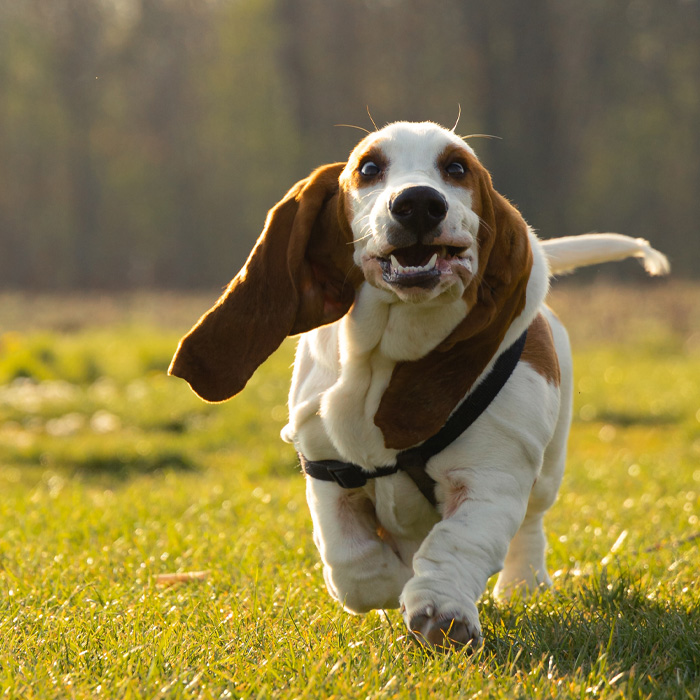With so many breed variations ranging from the tiny Chihuahua to the giant Great Dane, sometimes it is hard to believe that all dogs evolved from a single ancestor, the gray wolf.
Varying in size, shape, color, and more, there are hundreds of unique dog breeds. One of the ways dog breeds vary is in the appearance of their ears.
Here will focus on breeds with floppy ears, some potential problems with floppy ears, and how to prevent them.
- Floppy-eared dogs risk ear infections 1.76-1.84x more than erect-eared breeds.
- Golden Retrievers excel as service dogs and family-friendly pets.
- Cocker Spaniels are popular for hunting & require regular grooming.
- Beagles are playful, great hunters, and known as escape artists.
- Dachshunds prone to disc damage; avoid overweight and high furniture.
This post may include affiliate links.
The information provided herein is for informational purposes only. Please refer to our disclaimer for more details..
What Do You Call Floppy Dog Ears?
Different breeds of dogs have ears of varying shape, size, and carriage. One variation of ear carriage is floppy ears. Floppy ears occur when the ear flaps, or pinnae, fold over and hang on the sides of a dog’s head.
These are also referred to as drop ears. These floppy-eared dogs are characterized by droopy, pendulous ears in a V-shaped, dropped ear carriage. This is in contrast to dogs with erect, pointy ears, referred to as prick ears.
What Dog Breeds Have Floppy Ears?
Who can resist a puppy’s face, especially when it is framed by soft, dangling ears? But what dog breeds have adorable floppy ears? Let’s take a closer look at 10 of the most popular dog breeds with floppy ears.
1. Dachshund
Image source: Niki Sanders
Popular for their distinct body type, Dachshunds are a small and spunky breed of the hound group. Dachshunds come in two sizes (standard and miniature) and three coat types (smooth, wirehaired, and longhaired).
Characterized by their long body and short legs, these dogs are not designed to be amazing long-distance runners or swimmers. Instead, these curious canine companions were bred to hunt prey. Their intelligence and bravery make them great watchdogs, but they also make lovely lap dogs.
This breed is prone to intervertebral disc damage, so it is essential to prevent them from becoming overweight and jumping on and off furniture.
2. Basset Hound
Image source: Casper Coomans
In addition to its long, droopy ears, the Basset Hound is known for its wrinkled, sad expression and stout stature. Although not the speediest of dogs, the Basset Hound still demonstrates great strength and endurance.
This mellow breed is mainly celebrated for its impeccable sense of smell, which can make them stubborn and persistent when walking on trails. But at home, these scent hounds are incredibly charming and loyal.
3. Bloodhound
Image source: Gary Smith
While long floppy ears are a hallmark physical trait of Bloodhounds, this breed is primarily known for its superior sense of smell. This Sleuth Hound breed is commonly used as a working dog to track down lost or missing people.
Sometimes, Bloodhounds can get distracted by a scent, making obedience challenging. But as long as you don’t mind the extra drool, these gentle giants make friendly companions.
4. Afghan Hound
Image source: Arve Kern
With long, flowing locks, one of the most striking breeds in the hound group is the Afghan Hound. Its elegant and luscious coat is not just for looks but reflects the harsh mountainous climate where the Afghan Hound originated from.
Afghan Hounds also have large paw pads designed to withstand long hunting days. This unique-looking breed is independent and sweet, but these dogs can be high maintenance as they require a lot of grooming.
5. Cocker Spaniel
Image source: Stainless Images
Loved for their precious puppy dog eyes and cheerful personalities, Cocker Spaniels are among the most popular floppy-eared breeds. There are two types of Cocker Spaniels: the English Cocker Spaniel and the American Cocker Spaniel. Their medium size makes Cocker Spaniels well-rounded companions and great family dogs.
Don’t let their glamorous coat fool you; Cocker Spaniels are part of the sporting group and were originally bred as hunting dogs. So, if you plan to add a Cocker Spaniel to your family, ensure you can provide adequate grooming and exercise.
6. Poodle
Image source: Goochie Poochie Grooming
Despite the many, sometimes bold, grooming variations, Poodles are always easily recognizable by their curly coats. But this breed is also extremely smart and athletic. Because of this, poodles are usually easy to train and are obedient.
Ranging from about 4 to 70 pounds, Poodles come in three sizes: toy, miniature, and standard. Despite the stereotypes, Poodles are so much more than a fancy haircut. This breed can bring a lot of joy to you and your family.
7. Beagle
Image source: Mark Rimmel
Affectionately referred to as a merry dog, the Beagle is the most popular breed in the hound group. They are relatively small dogs and come in two sizes. Beagles make great hunting dogs but are also playful, making them excellent family dogs.
These loving and energetic pups require plenty of activity. Also, note that Beagles can be quite the escape artist so if you decide to own one, ensure the environment is secure.
8. Golden Retriever

Image source: David Moynihan
The Golden Retriever is another breed of dog with floppy, albeit shorter ears. Originating from Scotland, this beautiful breed is not just for show but is one of the most diverse working and service dogs. Golden Retrievers excel as guide dogs, search-and-rescue dogs, and hunters.
But when they are not working, these intelligent and friendly dogs also serve as a great addition to the family. Given their playful and loyal disposition, it is no wonder that Golden Retrievers are a favorite in the dog world.
9. Labrador Retriever
Image source: Fernando Gago
Perhaps remembered more for its sweet face and demeanor than its floppy ears is the ever-popular Labrador Retriever. Labradors are a British breed created for sporting and hunting. Their water-resistant coat makes them perfect for waterfowl hunting.
Additionally, Labrador Retrievers are commonly used as service or therapy dogs. These large dogs are incredibly friendly and loving but also have much energy. So before committing to one, ensure you can provide adequate mental and physical stimulation for your pup.
10. Irish Setter
Image source: Adam Wheater
There are multiple types of Setters, but the floppy-eared breed we will look at is the Irish Setter. This beautiful dog is known for its shiny, lush red coat. While certainly elegant, the Irish Setter is also an athlete, and its powerful legs make it one of the fastest sporting dogs. Irish Setters are sweet-natured social companions who love to be around adults, children, and other dogs alike.
Potential Problems with Floppy Ears
Although dogs with floppy ears are insanely cute, floppy ears can also present some problems.
One potential issue with floppy ears is a greater risk of otitis externa or ear infection. Floppy ears are considered a predisposing factor for ear infections. Predisposing factors, like ear structure, change the environment inside their ears. For example, floppy ears may be associated with greater humidity within the ear, making inflammation and infection more likely to develop. One study showed that dog breeds with floppy ears have a 1.76 to 1.84 times greater risk of developing an ear infection than breeds with erect ears.
Another potential condition that floppy-eared dogs can develop is an aural hematoma. An aural hematoma is a blood-filled swelling under the skin within the ear flap. This occurs from trauma associated with excessive head-shaking or scratching of the ears, which is familiar with itchy ear infections.
How to Clean Floppy Ears
Keeping your dog’s ears clean is essential regardless of their breed. But it is especially crucial with floppy-eared dogs to prevent dirty and infected ears.
First, choose an appropriate ear-cleaning solution. Consult your veterinarian regarding what type of cleaning solution to use since there are many options, both over-the-counter and prescription, with many different types of ingredients.
You will also need to defer to your veterinarian regarding the frequency of ear cleaning. Typically, if a dog has an ear infection, cleaning is recommended twice a week. Otherwise, weekly regular cleaning is usually appropriate. It is important to note that excessive cleaning can also lead to ear infections.
To clean your dog’s ears, I recommend soaking a large cotton ball in solution. Then, place the wet cotton ball inside the ear, close the flap over it, and massage the base of the ear. This will squeeze the solution deeper into the ear canal and is more gentle than directly squirting the solution into the ear. Then, use dry cotton balls to remove any debris. Never use cotton-tipped applicators like Q-tips since these can rupture the ear drum!
Are Dogs with Floppy Ears Less Aggressive?
In 2018, TSA (the Transportation Security Administration) transitioned from dogs with pointy ears to those with floppy ears. TSA reasoned that passengers, particularly children, are less fearful and, therefore, more accepting of floppy-eared dogs. But are dogs with floppy ears truly more friendly?
Charles Darwin observed an association between floppy ears and behavior. Referred to as the “domestication syndrome,” Darwin suspected that some mammals with floppy ears were more tame than those with perky ears.
Regardless, we must remember that regardless of ear structure, each dog has a distinct personality as an individual and that aggression cannot be accurately predicted based on appearance alone.
What Are the Benefits of Floppy Ears in Dogs?
It has been proposed that floppy ears help hone a dog’s sense of smell. This is because floppy ears slightly inhibit a dog’s hearing. By dampening potentially distracting noises, floppy ears encourage a dog to rely more on his sense of smell. For breeds with particularly long ears, like the Bloodhound, their ears may also kick up scent particles from the ground, making them easier to detect.
Whether or not floppy ears significantly enhance a dog’s smell or decrease aggression, we cannot deny that floppy ears certainly add to a dog’s cuteness.
1Kviews
Share on FacebookExplore more of these tags
I LOVE dogs (as one may have guessed, I love all canids) but these "dog articles" on BP are getting out of hand. I don't mind more dog CONTENT, that's not what I'm saying, but I AM saying that the article SUBJECTS are ridiculous and getting more ludicrous. "10 dog breeds with floppy ears" - OMG GUYS! I NEVER would have been able to notice which breeds had floppy ears just by LOOKING AT THEM or anything!!! What a USEFUL ARTICLE!! And remember the "10 most aggressive dog breeds" that literally listed SAINT BERNARDS as a runner-up as one of the most aggressive breeds? And the contemporary "How to keep dogs warm outside" article that literally ONLY LISTS "put booties and a coat on them!!!!!" like.... yes? I think we all knew that?
I LOVE dogs (as one may have guessed, I love all canids) but these "dog articles" on BP are getting out of hand. I don't mind more dog CONTENT, that's not what I'm saying, but I AM saying that the article SUBJECTS are ridiculous and getting more ludicrous. "10 dog breeds with floppy ears" - OMG GUYS! I NEVER would have been able to notice which breeds had floppy ears just by LOOKING AT THEM or anything!!! What a USEFUL ARTICLE!! And remember the "10 most aggressive dog breeds" that literally listed SAINT BERNARDS as a runner-up as one of the most aggressive breeds? And the contemporary "How to keep dogs warm outside" article that literally ONLY LISTS "put booties and a coat on them!!!!!" like.... yes? I think we all knew that?

 Dark Mode
Dark Mode 

 No fees, cancel anytime
No fees, cancel anytime 



























































5
3